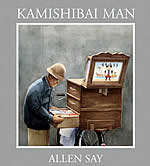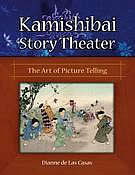 |
Kamishibai Man by Allen Say
An elderly kamishibai (paper theater) man decides to return to the city and spend the day on his former rounds. His wife makes candies for him, just as in the past, and he sets off on his bicycle. Things have changed–there's traffic with honking horns and he wonders, Who needs to buy so many things and eat so many different foods? when he sees the shops and restaurants replacing beautiful trees that have been cut. He sets up his theater and begins to tell his personal story of being a kamishibai man in a flashback sequence. Soon he is surrounded by adults who remember him and his stories from their youth. Ironically, that night he is featured on the news on television–the very technology that replaced him. (Excerpt School Library Journal) |
 |
Kamishibai Story Theater by Dianne de Las Casas
De Las Casas has adapted 25 folktales from across Asia for whole classroom use, borrowing a Japanese method of storytelling through pictures. Kamishibai theater harkens back to itinerant storytellers (Kamishibai Men) who conveyed their tales by means of illustrated cards slid into slots in wooden stages built on the back of their bicycles. This book includes an introductory chapter describing in detail the methods to use in coaching students in the art of Kamishibai Story Theater. It offers tips on rehearsing, and detailed discussion and background of the Kamishibai processes, and it describes how to coordinate grade-level story presentations. Reproducible tales can be distributed to each member of the class to aide in creating illustrations. Spot illustrations for each tale give students an idea of the flavor of their drawings for that story. The stories in Kamishibai Story Theater will delight children in grades 2-6, enticing them to participate in their own story fest. (Amazon)
|